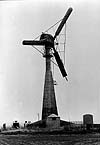The Wind Energy
Pioneers:
The Gedser Wind Turbine

Johannes
Juul and the Vester Egesborg Turbines

![]() The
engineer Johannes Juul was one of the first students of Poul La Cour in
his courses for "Wind Electricians" in 1904.
The
engineer Johannes Juul was one of the first students of Poul La Cour in
his courses for "Wind Electricians" in 1904.
![]() In the 1950s J. Juul became a pioneer in developing the world's first
alternating current (AC) wind turbines at Vester Egesborg, Denmark. (57K JPEG)
In the 1950s J. Juul became a pioneer in developing the world's first
alternating current (AC) wind turbines at Vester Egesborg, Denmark. (57K JPEG)

The
Gedser Wind Turbine

![]() The innovative 200
kW Gedser wind turbine (35K
JPEG) was built in 1956-57 by J. Juul for the electricity company SEAS
at Gedser coast in the Southern part of Denmark.
The innovative 200
kW Gedser wind turbine (35K
JPEG) was built in 1956-57 by J. Juul for the electricity company SEAS
at Gedser coast in the Southern part of Denmark.
![]() The three-bladed upwind turbine with electromechanical yawing and an
asynchronous generator was a pioneering design for modern wind turbines,
although its rotor with guy wires looks a bit old fashioned today.
The three-bladed upwind turbine with electromechanical yawing and an
asynchronous generator was a pioneering design for modern wind turbines,
although its rotor with guy wires looks a bit old fashioned today.
![]() The turbine was stall controlled,
and J. Juul invented the emergency aerodynamic
tip brakes which were released by the centrifugal force in case of over
speed. Basically the same system is used today on modern stall controlled
turbines.
The turbine was stall controlled,
and J. Juul invented the emergency aerodynamic
tip brakes which were released by the centrifugal force in case of over
speed. Basically the same system is used today on modern stall controlled
turbines.
![]() The turbine, which for many years was the world's largest, was incredibly
durable. It ran for 11 years without maintenance.
The turbine, which for many years was the world's largest, was incredibly
durable. It ran for 11 years without maintenance.

(Photographs © the Electricity Museum, Bjerringbro).
The
Nibe Turbines
After the first oil crisis in 1973, interest in wind energy rekindled in
several countries. In Denmark, the power companies immediately aimed at
making large turbines, just like their counterparts in Germany, Sweden,
the UK, and the USA.
![]() In 1979 they built two 630 kW wind turbines, one pitch
controlled, and one stall controlled.
In many ways they suffered the same fate as their even larger colleagues
abroad: The turbines became extremely expensive, and the high energy price
subsequently became a key argument against wind energy.
In 1979 they built two 630 kW wind turbines, one pitch
controlled, and one stall controlled.
In many ways they suffered the same fate as their even larger colleagues
abroad: The turbines became extremely expensive, and the high energy price
subsequently became a key argument against wind energy.
![]()
| Back | Home | Forward |
© Copyright 1998 Søren Krohn.
Updated 6 August 2000
http://www.windpower.org/pictures/juul.htm